Résumés Année 2007
"Molecular tectonics: on the formation of 1-D silver coordination networks by thiacalixarenes bearing nitrile groups"
M. N. KOZLOVA, S. FERLAY, S. E. SOLOVIEVA, I. S. ANTIPIN, A. I. KONOVALOV, N. KYRITSAKAS, M. W. HOSSEINI, Dalton Trans., 2007, 5126-5131. (download .pdf)
Abstract: Two new p-tertbutylthiacalix[4]arene derivatives 2 and 3 decorated at the lower rim with four nitrile groups have been prepared and structurally characterised in the crystalline phase. The two ligands, differing by the length of the spacer between the calix moiety and the nitrile group, adopt the 1,3-alternate conformation in the solid state. The ligand 3 bearing four (CH2)3CN fragments behaves as a tecton in the presence of silver salts (AgX, X = BF4, PF6 or SbF6) and leads to the formation of analogous 1-D linear coordination networks. The tecton 3 acts as a bis chelate unit and bridges consecutive silver cations adopting a tetrahedral coordination geometry. Anions and solvent molecules occupy the free space between networks and exhibit no specific interactions with the cationic architecture.
 | 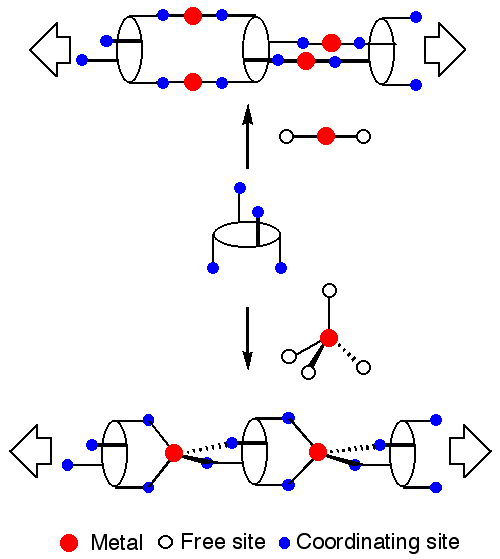 | 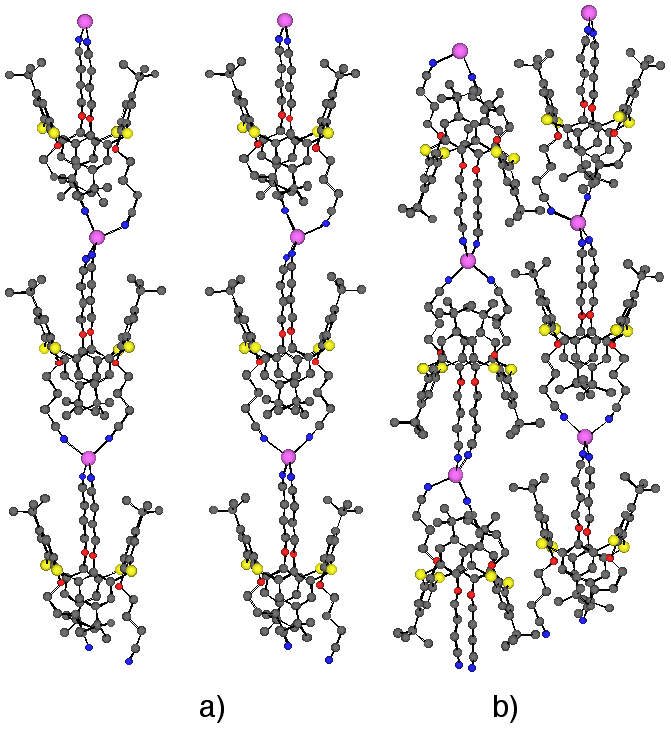 |
"Molecular tectonics: polymorphism and enhancement of networks dimensionality by combination of primary and secondary H-bond sites"
P. DECHAMBENOIT, S. FERLAY, M. W. HOSSEINI, N. KYRITSAKAS, Chem. Comm., 2007, 4626-4628. (download. pdf)
Abstract: A dicationic tecton bearing four NH and two OH groups as primary and secondary H-bond donor sites respectively leads in the presence of [M(CN)4]2- anions to the formation of polymorphic 2- and 3-D H-bonded networks.
 |  |  |
"Heterobimetallic coordination networks based on metallaporphyrins bearing four pyridine N-Oxide groups as coordinating sites"
E. DEITERS, V. BULACH, M. W. HOSSEINI, Dalton Trans., 2007, 4126-4131. (download .pdf).
Abstract : The combination of two metallaporphyrin based tectons bearing four pyridyl-N-oxide groups with HgBr2 or PbI2 complexes lead to the formation of 3-D heterobimetallic coordination networks which were characterised in the crystalline phase by X-ray diffraction on single crystals. Both lone pairs of the oxygen atom of the pyridyl-N-oxide group participate in either coordination to the metal centre or in establishment of H-bonds with protic solvents.
 | 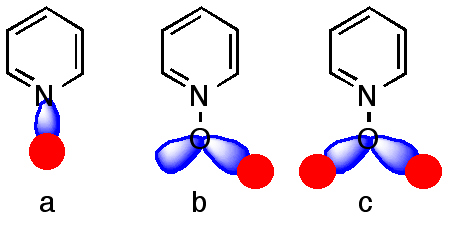 |  |
"A molecular gate based on a porphyrin and a silver lock"
A. GUENET, E. GRAF, N. KYRITSAKAS, L. ALLOUCHE, M. W. HOSSEINI, Chem. Comm., 2007, 2935-2937. (download .pdf)
Abstract: A Sn(IV) metallaporphyrin bearing a 4-pyridyl group on one meso position and a handle equiped also with a pyridyl unit funstions in solution as molecular gate in the presence of silver cation. The complexation/decomplexation of Ag(I) corresponds to the opening and closing motions of the gate.
 |  |  |
"Beyond classical coordination: silver-π interactions in metal dipyrrin complexes"
D. SALAZAR-MENDOZA, S. A. BAUDRON, M. W. HOSSEINI, Chem. Comm., 2007, 2252 - 2254 (download .pdf)
Abstract: Homo- and hetero-leptic Zn and Cu complexes of dipyrrin type ligands bearing mono- and di-cyanophenyl groups when combined to silver cation lead to the formation of Ag(I) - C=C double bond interactions unprecedented in the crystalline phase.
 | 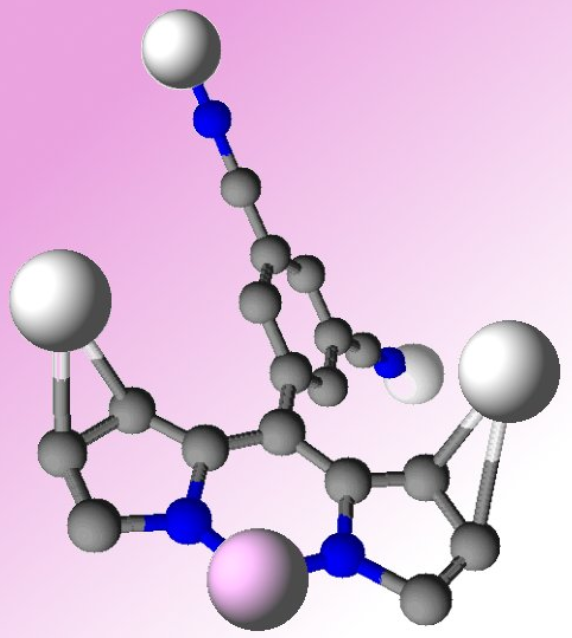 |  |
"Investigations on crystalline interface within a molecular composite crystal by microscopic techniques"
E. F. BRES, S. FERLAY, P. DECHAMBENOIT, H. LEROUX, M. W. HOSSEINI, S. REYNTJENS, J. Mat. Chem., 2007, 1559-1562. (download .pdf)
Abstract: The interface in a composite crystal made by 3-D epitaxial growth of crystalline layers on a seed crystal was studied by both TEM and FIB/STEM microscopies which revealed a diffuse interface between the two isostructural phases extending over ca 0.7 μm.
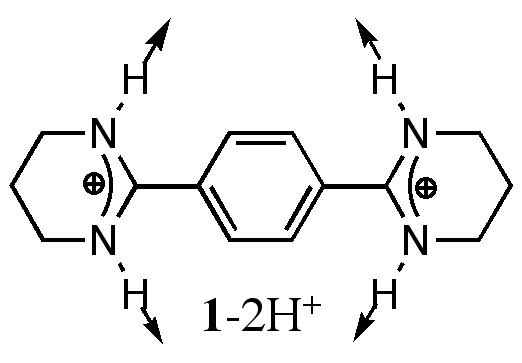 | 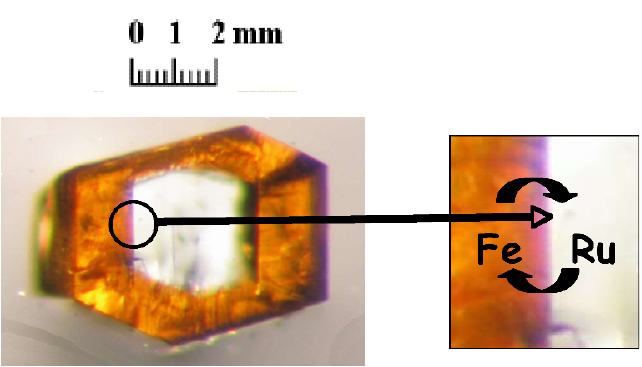 |  |
"Arranging up to Six Ferrocene Carboxamides around Metal Centres"
D. SALAZAR-MENDOZA, S. A. BAUDRON, M. W. HOSSEINI, N.KYRITSAKAS, A. DE CIAN Dalton Trans., 2007, 565-569.(download .pdf)
Abstract: Ferrocene carboxamide, FcCONH2, forms homo- and heteroleptic complexes with Co(II), Ni(II) and Cu(II) via coordination of its carbonyl group. Whereas for both Co(II) and Ni(II), hexaferrocenyl complexes are obtained in the presence of BF4- anion, in the case of Cu(II) a tetraferrocenyl species is observed in the presence of triflate anion.
 |  |  |
"Molecular tectonics on surfaces: bottom-up fabrication of 1-D coordination networks forming 1D and 2D arrays on graphite"
M. SURIN, R. SAMORI, A. JOUAITI, N. KYRITSAKAS, M. W. HOSSEINI, Angew. Chem. Int. Ed., 2007, 46, 245-249.(download .pdf)
Abstract: STM studies on combinations of a rigid and flat coordinating tecton bearing both a monodentate and a tridentate coordination poles with either Co(II) as its chloride complex or Pd(II) in the presence of BF4- anions revealed the formation of long and persistent 1-D and 2-D arrays on the graphite – solution interface.
 |  |  |
"A stepwise approach to the formation of heterometallic discrete complexes and infinite architectures"
S. BAUDRON, M. W. HOSSEINI, N. KYRITSAKAS, M. KURMOO, Dalton Trans., 2007, 1129–1139.(download .pdf)
Abstract: A strategy for the controlled construction of heterobimetallic discrete complexes and 1-D coordination networks is presented. The organic ligand L based on the methanedithiolate group and the 4,5-diazafluorene moiety behaving as primary and secondary coordination poles respectively leads to the formation of a series of discrete metal complexes with various geometries via binding through the dithiolate site. The observed coordination geometries range from square-planar for Ni(II) and Pd(II) to distorted tetrahedral for Zn(II) and Hg(II). The square-planar Pd(II) complex affords a discrete bimetallic trinuclear complex when treated with a capped Ni(II) center. All three Ni(II), Pd(II) and Hg(II) discrete complexes have been also shown to behave as metallatectons leading to the generation of infinite networks in the presence of bridging cations such as sodium.
 |  |  |
"Molecular tectonics: generation of 1-D interdigitated and 2-D interwoven helical silver coordination networks by oligoethylene glycol based backbones bearing two benzonitrile moieties"
J. BOURLIER, M. W. HOSSEINI, J.-M. PLANEIX, N. KYRITSAKAS, New. J. Chem., 2007, 31, 25-32.(download .pdf)
Abstract: Ligands based on oligoethylene glycol units bearing at their extremities benzonitrile groups behave in the crystalline phase as tectons and lead in the presence of silver cation to different coordination networks. Depending on the number of glycol units, 1-D stair type or 1-D interdigitated and 2-D interwoven architectures composed of helical strands are obtained.
 |  |  |


